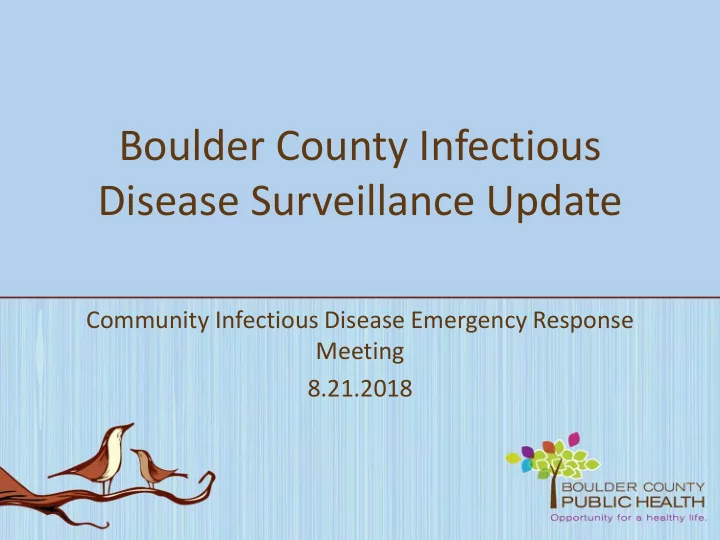

Boulder County Infectious Disease Surveillance Update Community Infectious Disease Emergency Response Meeting 8.21.2018
Reportable Conditions Investigated by BCPH 46% compared to 5 800 250 year average (2012-2016) Total Cases Rate per 100,000 700 200 600 Number of Cases Rate per 100,000 21% compared to 500 Pertussis Epidemic Year 150 Pertussis Epidemic Year pertussis epidemic year 400 100 300 (2013) 200 50 100 0 0 2012 2013 2014 2015 2016 2017
Total Number of Reportable Conditions Investigated 2018 Compared to 5 Year Average 160 8% compared to 140 5 Year Average (2013-2017) 2017 YTD 2018 120 Number of Cases 100 80 60 40 20 0
2017-2018 Influenza Season Recap • High severity, H3N2-predominant season with record-breaking level of influenza-like illness and hospitalizations. • Between October 1, 2017-May 26, 2018 – 4,675 hospitalizations statewide/ 260 in Boulder County – 183 outbreaks/14 in Boulder County (Assisted and Skilled Nursing) – One pediatrics death in the state – One novel influenza A variant (H1N2v)
2018-2019 Influenza Season What communications/data going into and during the 2018-2019 Influenza season would be helpful to you/your organization?
Common Reportable Conditions (January 1, 2018-July 31, 2018) 8 Vibrio 4 4 Shigella 6 Cyclospora: 100% out of state (3)/country (5) 17 Yersinia 7 1 Cyclospora Cryptosporidium: 56% out of state (3)/country (9) 8 9 Shiga-toxin producing E.Coli 17 5-YR Mean (2013-2017) YTD STEC: 59% out of state (1)/country (9) 6 Cryptosporidium 2018 YTD 19 17 Salmonella 22 Campylobacter: 65% out of state (11)/country (32) 24 Giardia 23 57 Pertussis 43 47 Campylobacter 66 0 10 20 30 40 50 60 70
Campylobacter Surveillance 40 35 Boulder CO CO 30 Rate per 100,000 25 20 15 10 Healthy People 2020 Goal 5 0 1999 2000 2001 2002 2003 2004 2005 2006 2007 2008 2009 2010 2011 2012 2013 2014 2015 2016 2017 2018
Enteric Pathogen Testing in Boulder County
Colorado Rabies Update • 277 specimens have tested positive for rabies in Colorado. – 202 skunks, 63 bats, 3 raccoons, 1 alpaca, 8 cat/dog – Boulder County: bat (2); skunk (1) • This number of positive animals surpasses the previous season high of 191 in 2013. • Of 277 rabid animals, 132 were known or strongly suspected of exposing 277 domestic pets, 92 livestock and 86 people. • Rabies risk assessments and rabies PEP recommendations have been made for 24 Boulder County residents thus far this year.
West Nile Virus Activity by State, 2018 *August 7, 2018
Colorado West Nile Virus Update • 8 cases of human West Nile Virus (WNV) have been reported/confirmed as of August 20, 2018 in Delta (1), Larimer (4) and Weld (3) counties. – uncomplicated fever cases (67%) – meningoencephalitis case (33%) – No fatalities have been reported • 85 mosquito pools tested positive state-wide and were collected from Adams (2), Boulder (10), Larimer (53), and Weld (20)
U.S.-Based Ongoing Outbreak Update June 2018: Multistate Multistate (10) Outbreak (44) Outbreak of August 2018: Multistate Salmonella (Live poultry) of Hepatitis A (15) Outbreak of Cyclosporiasis (McDonalds) June 2018: Multistate (9) Outbreak of Salmonella (Pre-cut July 2018: Multistate (9) melon) Outbreak of Salmonella (Pasta Salad) July 2018: Multistate (26) Outbreak of Salmonella (Ground June 2018: Multistate Turkey) (33) Outbreak of Salmonella (Honey July 2018: Multistate (4) Smacks) Outbreak of Vibrio parahaemolyticus (Crab meat)
Hepatitis A Outbreak Continues in Multiple States Across the U.S. • CDC and state health departments continue to investigate HAV outbreaks in multiple states among persons reporting injection drug use and/or experiencing homelessness and their contacts. • Colorado returned back to baseline rates of reported hepatitis A cases in November 2017 (~30/year). • Eight cases of hepatitis A have been reported in Colorado in 2018; and one case was both experiencing homelessness and reported injection drug use. No cases have been reported in Boulder County in 2018. • • BCPH continues to provide the Hepatitis A vaccines at the Boulder Shelter and at BCPH- walk-in, appointment and during regular clinic hours.
Enterovirus A71 (EV-A71) Update CDPHE continues to investigate a number of cases of neurologic • disease (meningitis, encephalitis, acute flaccid myelitis) associated with enterovirus A71 (EV-A71) infection in children. Cases are all under age 3 years with no underlying medical • conditions. Symptoms include fever, irritability, myoclonus, ataxia, rash, weakness, vomiting, and diarrhea. • Consider collecting throat, rectum and cerebrospinal fluid (CSF) samples from children with aseptic meningitis, encephalitis, or other central nervous system infections for enteroviral PCR testing. – EV-A71 is often not detected by PCR in CSF, so CDPHE recommends simultaneous testing from all three sites. • Please report all cases of meningitis, encephalitis, AFM, or other neurologic complications in patients who test positive for enterovirus to CDPHE.
Antibiotic Resistant Bacteria Surveillance Updates
Recent carbapenem-resistant bacteria surveillance changes November 2015: Carbapenem-resistant July 2018: Pseudomonas Additional CRE aeruginosisa ( CRPA) organisms: Citrobacter , statewide lab Serratia , Raoultella , January 2016: reportable condition Proteus , Providencia , CRE definition and Morganella ; AND change carbapenemase- producing CRE (CP-CRE) of any genus/species November 2012: reportable Carbapenem-resistant Enterobacteriaceae (CRE) statewide lab reportable condition Carbapenem-resistant Acinetobacter baummannii (CRAB) reportable in the 5-county Denver metro area
Extended-spectrum beta-lactamases (ESBLs) Surveillance in Boulder • ESBLs are enzymes that mediate resistance to extended-spectrum (third generation) cephalosporins (e.g., cefotaxime, ceftriaxone) and monobactams (e.g., aztreonam) but do not affect cephamycins (e.g., cefoxitin and cefotetan) or carbapenems (e.g., meropenem or imipenem). • ESBLs became reportable in Boulder County starting July 15, 2018.
Antimicrobial Stewardship • The first Colorado Antibiogram is nearly complete. – Publically available tool of antibiotic stewardship that will inform population level antibiotic stewardship strategy – Summary of susceptibility of bacteria cultured from clinical specimens in 2016 – Data pooled from antibiogram of individual hospitals (N=66), skilled nursing (n=86), and assisted living facilities (n=170)
Questions?
Recommend
More recommend